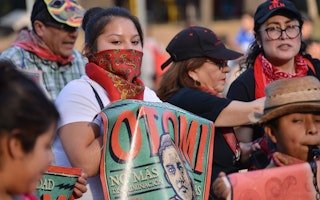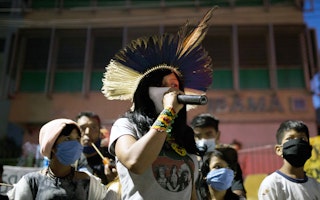How Resilience Workers Help Combat the Climate Crisis
By Saket Soni

“Where are you calling from?"
The man on the line was too scared to give his name or the name of the company for whom he was working. All I knew was that his area code placed him on the stretch of the Mississippi coast that had been recently devastated by Hurricane Katrina. And he spoke with a broad Punjabi accent; he might have been one of my uncles.
“America,” he answered. “At least that’s what they tell me.”
It was 2006, and I was working as a labor organizer at the New Orleans Workers’ Center for Racial Justice. My phone number circulated in unpredictable ways, often resulting in unexpected phone calls.
The caller, I soon discovered, was one of 500 laborers brought from India to the U.S. Gulf Coast to repair hurricane-damaged oil rigs. Their employer was a Mississippi-based oil rig builder called Signal International. The company and its recruiters had falsely promised the men green cards, convincing them to pay up to $20,000 for what sounded like the opportunity of a lifetime.
They arrived with visions of a middle-class life that would enable them to bring their families across the ocean after them. But the promise of an American Dream quickly became an American nightmare.
The men were trapped in one of the biggest forced labor schemes in modern U.S. history. They worked round-the-clock shifts, lived behind a barbed wire fence on company property, and were only allowed to venture outside once a week on supervised trips to Walmart or church. They were charged $1,000 a month in rent to sleep 24 men to a trailer on company property. They were served frozen rice they had to suck on to thaw.
Over weeks of secret meetings, I helped the men orchestrate in a mass escape from the camp. But that was only the start of a years-long fight for justice—a fight that included a march from New Orleans to Washington, D.C., a hunger strike, a federal lawsuit, and countless meetings on Capitol Hill. Our initial goal was to have the government grant the men “continued presence” during its investigation into our forced labor complaint: the legal means to temporarily live and work in the U.S. without fear of deportation.
But we were up against bigger forces than we knew. Immigration and Customs Enforcement (ICE) blocked our efforts to secure continued presence, and surveilled, harassed, and targeted the men every step of the way.
In time, we discovered the darkest reason why: ICE had colluded with Signal to keep the men trapped. We blew the whistle on the collusion, and the men were finally recognized as victims of forced labor and granted permission to start new American lives with their families. Signal put the blame squarely on recruiters for misleading workers about the terms of the work visas that brought them to the U.S. But in 2015—nine years after I got that first phone call—a federal jury awarded the men over $14 million in damages.
Since Hurricane Katrina, there have been over 200 U.S. climate disasters that have done a billion dollars’ worth of damage or more each. This is our new normal: ever more powerful and destructive storms, floods, and fires. And our recovery in their aftermath depends on a new workforce of largely migrant workers—what we call the Resilience Workforce.
Though I didn’t know it at the time, the Indian workers I met in 2006 were among the first of these resilience workers. Since then, this workforce has grown in size, skill, and commitment, though it remains extraordinarily vulnerable. Resilience workers face constant instability and life-threatening conditions. They’re separated from the multibillion-dollar contractors at the top of the disaster recovery industry by layers of subcontracting and earn poverty wages on contracts worth hundreds of millions of dollars. Many of them are undocumented migrants, which means they’re subject to political fearmongering and scapegoating. Last year, undocumented resilience workers were critical to the rebuilding of Florida after Hurricane Ian, even while Governor Ron DeSantis targeted them with political stunts and draconian anti-immigrant legislation.
I co-founded Resilience Force in 2017 to help formalize and protect the workers who help us come home after climate disasters. Now we’re in a moment when the resilience economy—rebuilding, weatherizing, and decarbonizing America—is poised to receive $2 trillion in federal investment over the next decade. The workers will be at the center of that economy, and there aren’t nearly enough of them.
We need to develop today’s resilience workers into the core of the million-strong workforce America needs. With it, we can be better prepared than ever to help people come home after storms—but that’s only the beginning. We can do the kind of green adaptation and retrofitting work that will build a climate-resilient future for all Americans, while creating new pathways to the middle class for formerly excluded workers. And we can rewrite the rules of recovery after climate disaster, which too often drive economic and racial inequality, but can be made to combat it.
The Indian workers’ story provided a glimpse into the climate future that was coming—a future that is now here. By building the resilience workforce we all need, we can build a climate future in which we don’t just survive but thrive.
Resilience Force is a grantee of the Open Society Foundations.
Saket Soni is founder and director of Resilience Force, and author of "The Great Escape: A True Story of Forced Labor and Immigrant Dreams in America."


